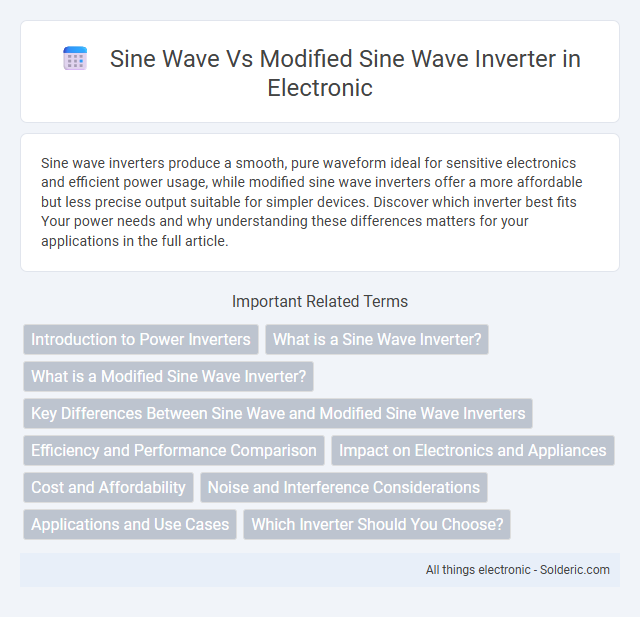Sine wave inverters produce a smooth, pure waveform ideal for sensitive electronics and efficient power usage, while modified sine wave inverters offer a more affordable but less precise output suitable for simpler devices. Discover which inverter best fits Your power needs and why understanding these differences matters for your applications in the full article.
Comparison Table
| Feature | Sine Wave Inverter | Modified Sine Wave Inverter |
|---|---|---|
| Output Waveform | Pure sine wave, smooth and continuous | Approximate square wave with steps |
| Compatibility | Compatible with all AC devices including sensitive electronics | Works with basic appliances, may cause issues with sensitive electronics |
| Efficiency | High efficiency, cleaner power output | Lower efficiency, may produce noise and heat |
| Price | Higher cost due to complex technology | More affordable and cost-effective |
| Applications | Medical equipment, audio/video devices, advanced electronics | Simple tools, lights, some household appliances |
| Power Quality | Stable voltage and frequency output | Less stable, signal may cause interference |
Introduction to Power Inverters
Power inverters convert DC electricity from sources like batteries or solar panels into AC electricity suitable for household appliances and electronics. Sine wave inverters produce a smooth, continuous waveform that closely replicates utility power, ensuring compatibility with sensitive devices and higher efficiency. Modified sine wave inverters generate a stepped, square-like waveform that is less expensive but may cause noise, reduced performance, and incompatibility with certain equipment.
What is a Sine Wave Inverter?
A sine wave inverter converts direct current (DC) from batteries or solar panels into an alternating current (AC) that closely mimics the smooth, continuous waveform of utility grid power, ensuring compatibility with sensitive electronics and appliances. Unlike modified sine wave inverters, which produce a stepped waveform approximating a sine wave, sine wave inverters generate a pure, consistent AC output that reduces harmonic distortion and electromagnetic interference. This high-quality power output is essential for devices like medical equipment, audio systems, and advanced electronics requiring stable and clean electricity.
What is a Modified Sine Wave Inverter?
A Modified Sine Wave Inverter generates a stepped waveform that approximates a pure sine wave by producing a square wave with pauses, allowing it to power most household electronics efficiently. Unlike pure sine wave inverters, modified sine wave inverters are less complex and more affordable but may cause humming or reduced performance in sensitive devices such as audio equipment or microwaves. These inverters are suitable for applications like simple tools, lighting, and battery charging where cost-effectiveness is prioritized over perfect waveform quality.
Key Differences Between Sine Wave and Modified Sine Wave Inverters
Sine wave inverters produce a smooth, continuous waveform that closely mimics the power from the electrical grid, making them ideal for sensitive electronics and appliances requiring stable power. Modified sine wave inverters generate a stepped waveform that approximates a sine wave but can cause inefficiency or noise in some devices, such as audio equipment or certain medical devices. Understanding these key differences helps you choose the right inverter based on your power quality needs and the specific devices you plan to operate.
Efficiency and Performance Comparison
Pure sine wave inverters deliver higher efficiency and superior performance, producing clean, smooth AC power that closely replicates utility electricity, ideal for sensitive electronics and appliances. Modified sine wave inverters, while more affordable, generate a rougher, stepped waveform that can cause increased heat, noise, and reduced efficiency in devices like motors and audio equipment. Efficiency ratings for pure sine wave inverters typically range from 85% to 95%, surpassing modified sine wave models, which generally fall between 70% and 85%, impacting overall energy consumption and device longevity.
Impact on Electronics and Appliances
Pure sine wave inverters deliver smooth, clean power that closely mimics utility grid electricity, ensuring optimal performance and longevity of sensitive electronics and appliances by reducing the risk of overheating, noise, and malfunction. Modified sine wave inverters produce a stepped waveform that can cause humming, increased heat, and reduced efficiency in devices with inductive loads, motors, and audio/video equipment. Electronics such as medical devices, variable speed tools, and certain battery chargers often require pure sine wave power to function correctly and avoid potential damage.
Cost and Affordability
Modified sine wave inverters are generally more affordable and cost-effective, making them a popular choice for budget-conscious users. Sine wave inverters tend to be more expensive due to their complex design and ability to produce cleaner, pure sine wave output suitable for sensitive electronics. Your choice depends on balancing upfront cost with the need for reliable, high-quality power delivery.
Noise and Interference Considerations
Pure sine wave inverters produce clean, smooth electrical output that minimizes noise and interference, making them ideal for sensitive electronics and audio equipment. Modified sine wave inverters generate a stepped waveform that can cause audible humming, electromagnetic interference, and potential malfunctions in certain devices. Choosing the right inverter for your setup ensures reduced noise disturbances and optimal performance of your electronic appliances.
Applications and Use Cases
Sine wave inverters provide clean, consistent power ideal for sensitive electronics such as medical devices, audio equipment, and computers, ensuring optimal performance and longevity. Modified sine wave inverters suit less sensitive appliances like power tools, simple motor devices, and lighting systems, offering a cost-effective solution with acceptable efficiency for basic use. Choosing the right inverter depends on device compatibility, with sine wave inverters preferred for precision equipment and modified sine wave inverters used for general household or industrial tools.
Which Inverter Should You Choose?
Choosing between a sine wave and modified sine wave inverter depends on the electrical devices you plan to power and their sensitivity to power quality. Pure sine wave inverters produce smooth, clean power ideal for sensitive electronics, medical equipment, and appliances with motors or microprocessors, ensuring optimal performance and preventing damage. Modified sine wave inverters are more affordable and suitable for simple tools and basic electronics but may cause inefficient operation or noise in sensitive devices.
Sine wave vs Modified sine wave inverter Infographic

 solderic.com
solderic.com